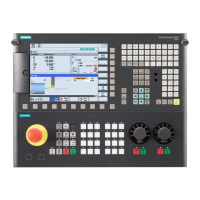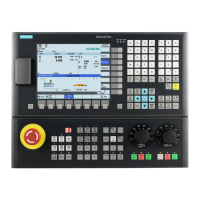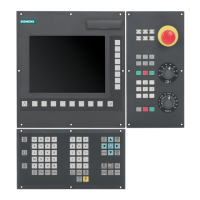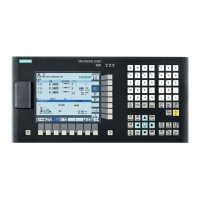M1: Kinematic transformation
6.6 Cartesian PTP travel
Extended Functions
Function Manual, 03/2013, 6FC5397-1BP40-3BA1
401
Alarm 10753: With PTPG0 and active TRC an internal switch-over to CP is done in order to
allow the tool radius correction to be performed correctly.
Alarm 10754: Still possible in case of conflict.
Alarm 10778: Still possible in case of conflict.
Alarm 10744: With PTPG0, CP travel is used for smooth approach and retraction (SAR), in
order to ensure correct processing of soft approach and retraction.
Alarm 10746: Still possible in case of conflict.
Alarm 17610: Transformation axes must not be configured simultaneously as positioning
axes traversed by means of POS.
Note
For further information about programming plus programming examples, please see:
References:
Programming Manual, Job Planning; Section Transformations, "Cartesian PTP Travel"
6.6.1 Programming of position
Generally speaking, a machine position is not uniquely defined solely by a position input with
Cartesian coordinates and the orientation of the tool. Depending on the kinematics of the
relevant machine, the joint may assume up to 8 different positions. These joint positions are
specific to individual transformations.
STAT address
A Cartesian position must be convertible into unique axis angles. For this reason, the
position of the joints must be entered in the
STAT address.
The
STAT address contains a bit for every possible setting as a binary value. The meaning of
these bits is determined by the relevant transformation.
As regards the transformations contained in the publication "Handling Transformation
Package (TE4)", the bits are assigned to different joint positions, as shown in the figure
above.

